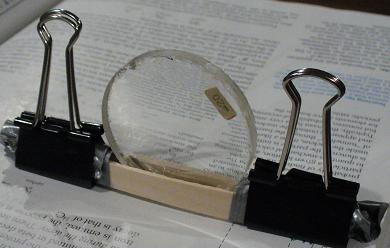
Green lasers are necessary for the demonstrations on this website. They are easily obtainable through websites such as Amazon and Ebay for about twelve dollars. The search term 'Green Laser' works, however they will be advertised as Laser Pens. While they do look like pens they (usually) do not write. They are about 5mW (5 milliWatts), and have a wavelength of 532nm (nanometers).
We used part number B001AAVVM0 from www.amazon.com.
Lenses come in various focal lengths and sizes. There are diverging lenses which can expan light and converging lenses which focus it. Diverging lenses are measured in negative focal lengths.
Lenses also come in two shapes: concave and convex.

We used diverging concave lenses with a diameter of 5 cm, and a focal length of -20 cm. These are available from www.sciencekit.com where they are part number 66723 M42.
Other lenses can be used, but we found that concave lenses are the simplest because they work with our 'Lens Mount Type One.'

Place a lens in a small binder clip. Use a piece of napkin or cloth as a barrier between the clip and the lens, to protect the lens. This does not always work, it is best for concave lenses.
Cut the napkin so that it will not interfere with the center of the lens. A piece of double sided foam tape can be used to mount it.

Materials: 2 popsicle sticks, duct tape, two binder clips, lens
A piece of mirror is used in the varying index of refraction demonstration. Mirror tiles can be obtained from stores such as Home Depot. A package of six 1 foot by 1 foot tiles cost about ten dollars.
Glass cutters can be used to cut mirrors. They can be found at Home Depot and similar stores. They cost about four dollars.
To cut a piece of mirror, use a straight edge. Pressure is needed to score deeply enough. The cut must be made in the correct spot the first time, or the mirror will not break properly. To break it, put the glass at the edge of a table holding one side in place. Gently push the other side so that it will break.
Old books, magazines, and paper make excellent stands for various equipment. Papers can be used to raise objects small increments. Similarly, any equipment roughly of a box shape will work.
Binder clips come in several sizes and can be used in various ways. The standard size fits well around a laser, forming both a stand and a way to keep the lasers on. They can be used to hold up pins and cards, and in general make simple but reliable stands.
The larger binder clips have 5/8" capacity and are 1 1/4" size. The small binder clips have 3/8" capacity and are 3/4" size. Magnets are useful because they can be baught in uniform sizes to create stacks, and because lasers and binder clips stick to them without making a permanent bond. This makes the construction of the meterstick apparatus easier. We used ceramic magnets measuring .395in x .875in x 1.875in (part number CB60NMAG) from www.magnetsource.com. We used map pins for our Poisson's Spot demonstration. at www.officedepot.com they are called map tacks (part number 866060).
Magnets

Map Pin/Tack
